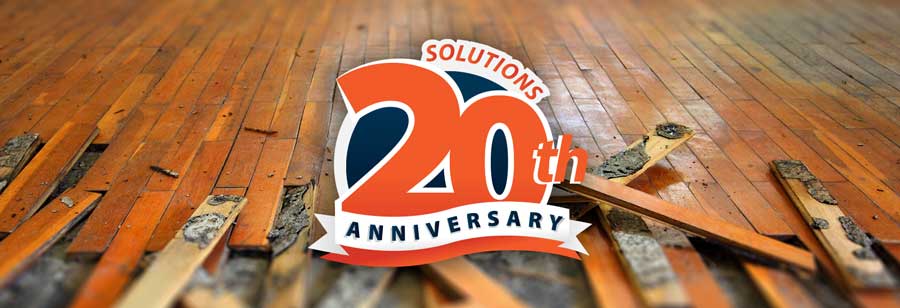In 2004, Adventist Risk Management published quarterly issues of SOLUTIONS specifically for international clients. Property loss is always a major risk that requires the proper care and maintenance of facilities, especially when it is caused by natural weather related events. Gideon Dayak, risk control consultant at ARM, addresses these exposures and how to prepare for storms to mitigate damaging losses.
2004—“The rain came down, the streams rose, and the winds blew and beat against that house; yet it did not fall, because it had its foundation on the rock" (Matt. 7:25).
Taking literally these words from Christ's parable of the wise and foolish builders, there are many practical steps that we can take to erect church properties on the rock and protect them from many dangers.
The Lord has blessed the Seventh-day Adventist Church with valuable land and buildings around the world, often in prime areas with a high real estate value. It is quite likely that your church, office, residential campus, school, hospital, nursing home, health center, farm, or industry operates from property that your organization or institution owns. Your property is a valuable asset and God expects you to be a good steward of it. You have a moral and social obligation to prevent damage to your property and injury to the people who occupy it.
Good stewardship involves safeguarding and maintaining your properties adequately. It includes protecting them against natural disasters such as floods, earthquakes and storms. The United States Geological Survey suggests that in an average year the world experiences about 100 extremely damaging and disruptive earthquakes, 100,000 thunderstorms, 10,000 floods, hundreds of landslides and tornadoes and scores of hurricanes, wildfires, volcanic eruptions, droughts and tsunamis.
This article provides common tips to help preserve your properties in good condition over a period of time. It also explores simple solutions to safeguard your real estate assets against some of the most frequently occurring types of natural disasters.
BUYING LAND
It all starts with the type of property you have.If you are planning to buy land, have it surveyed by a competent authority. It is also important to consider the following factors:
1. Location
Try to select land located in reasonable proximity to the areas where your organization's goals and activities extend. In addition, remember that locating your property in a bad neighborhood may result in irreparable loss to your institution.2. Land profile and topography
Consider whether the topography of the land is suitable to the type of building you want to construct. Grading the land to suit your needs can be a huge expense that you should try to avoid. For example, one church building project spent 30 percent of the estimated cost on grading the land in order to construct a building with different levels.3. Soil tests
Make sure soil tests are carried out for the land you're considering buying. The results of such tests will provide enough data to help chose surveying your property to determine whether the land is suited for its intended purpose. The tests also will show whether the land was used as a dump for toxic wastes, in which case you can avoid buying it.4. Boundaries
Ensure that the boundaries of the land you're buying are properly established and marked. Verify the land dimensions and area against the area documented in the proposed sale deed."The United States Geological Survey suggests that in an average year the world experiences about 100 extremely damaging and disruptive earthquakes and scores of hurricanes, wildfires, volcanic eruptions, droughts and tsunamis."
PROTECTING YOUR PROPERTY
Once you buy the land, put up a compound wall or a fence to protect against encroachment. With modern technology, we use closed-circuit TV monitors, but watchtowers offer added security to your land. They can also serve a dual purpose of acting as lightning arrestors, if they are installed with this feature. To protect your land, you must also:- Arrange for regular inspections of the entire property.
- Appoint a security guard, preferably a church worker and family, who can live on a small home on the property and care for it.
- Install sensor-activated yard lighting on the property.
DEVELOPING YOUR PROPERTY
While developing your property, here are some useful tips to keep in mind for the outdoors:- Install a catchment area or reservoir in a low-lying area of the property, so rainwater can be collected for irrigation.
- Plant tall trees on the periphery of the property, which will serve as effective windbreakers and keep wind losses to a minimum.
- Run all overhead electric cables on the periphery of the property, so that activities on the property will go undisturbed.
- Keep all open water wells on your property covered when not in use.
CARING FOR YOUR BUILDINGS
You spend most of your time inside buildings. So you want to make sure that the buildings you operate from are well-designed, well-planned and well-maintained at all times. Remember, your buildings must reflect your ministry and portray your diligence, cleanliness and commitment co excellence in what you do. Here are some essential maintenance activities you should carry out at regular intervals:- Paint all external walls, especially at the foundations of buildings, with waterproof paint to prevent water seepage.
- Arrange for regular electrical, plumbing and roof inspections to reduce the risk of short circuits and water leaks.
- If you have shingled roofs, replace the shingles periodically to preserve the underlying layers.
- If you have RCC (reinforced cement concrete) roofs, replace the waterproof course regularly.
- Arrange for pest control inspections to make sure no rodents can get into the foundation.
PROTECTING AGAINST NATURAL CALAMITIES
Floods, earthquakes and storms often come without warning. But if you know that you're located in a disaster-prone area, you can take special precautions to minimize the damage to your property when such disasters occur.Flood-prone areas: If you're located in a flood-prone area, it is wise to take the following precautions:
- Raise the plinth level of every building to a reasonable height above ground.
- Dig canals or trenches and build sandbanks and culverts in such a way as to divert the water to a catchment area in the low-lying areas of the property.
- Apply a water-repellent seal coating to the foundation wall to prevent any seepage.
- Keep all roads within the property open and clear, in case evacuation becomes necessary.
- Avoid storing anything in the low-lying areas.
- If you receive warnings of a flood with storms and lightning, it is best co evacuate all the people on the property. In such cases, be sure to disconnect all electrical power sources before leaving the property.
Earthquake-prone areas: If you're located in an area of known seismic activity (such areas are denoted on many maps), it is wise to take the following precautions:
- Make sure your architects and structural consultants take seismic loads into consideration while designing the buildings.
- Train all occupants of your property—arranging for drills, if possible—on emergency evacuation procedures.
Storm-prone areas: Storm, lightning and hail can cause extensive damage to buildings. A few basic steps can help to reduce destruction and losses from such calamities:
- Install an RCC roof to avoid destruction from hail.
- Set up a lightning arrestor on the highest building on your property.
- Grow tall trees around the boundary of the property, which will act as windbreakers in a fierce storm.
Remember that safety is a team effort. Therefore, educate your employees and other users of your property on the proper maintenance, care and use of your property. Prepare them for emergencies so that no one panics when disaster strikes.
In summary, proper stewardship of your land and buildings begins from the time you buy and develop the property. It includes routine maintenance activities and requires you to be aware of the potential natural disasters that may affect you, given your location, so that you can take adequate precautions. When you exercise good judgment and provide continuous care, your property, like the house of the wise man who built on the rock, will indeed not fall.
2015 UPDATE From the Author
2015—Reflecting on this article, written more than 10 years ago, we need to be more diligent today to protect church property as natural calamities, such as earthquakes, floods and tornadoes, become more frequent.To increase security, many of our institutions have installed security cameras to monitor the daily activities and events of our programs in churches, schools, childcare centers and hospitals.
In the interest of conservation and the increasing demand for water and power, it is worth considering better means to conserve water. Harvesting rainwater and, for larger Institutions, re-cycling water for use in irrigation are ways this can be done. In areas where it is feasible, institutions should also consider installing solar panels to wisely manage energy needs.
In conclusion, let us be watchful. When the Master of the House returns, He will find us to be faithful servants over the land and buildings entrusted to us.
This year, ARM celebrates 20 years of the weekly e-newsletter, Solutions, with the series Solutions Classic. Once a month we will publish a throwback piece from the Solutions archives and share the difference between risk management then and risk management now.


